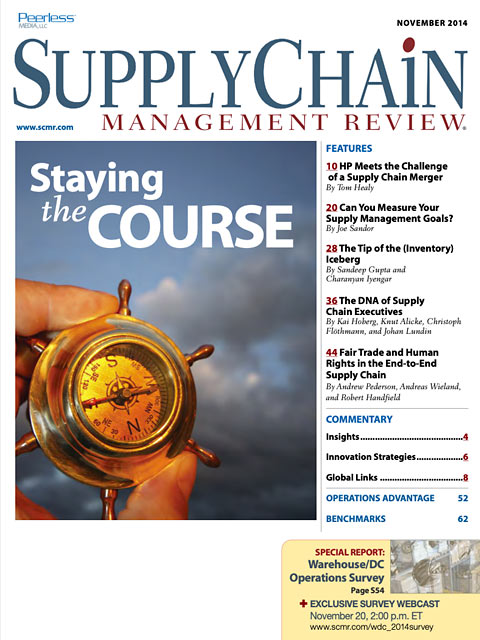Sorry, but your login has failed. Please recheck your login information and resubmit. If your subscription has expired, renew here.
November 2014
Supply chain managers are on the lookout for metrics that will allow them to put a number to their progress - or lack thereof. Welcome to KPI's that allow them to demonstrate the quantifiable value that they deliver. At the same time, Murphy's Law may intervene or they may be called upon to put out fires or come to the rescue and make good on the promises sales and marketing have made to customers - regardless of the cost. So, how do you measure success? I hope this month's issue and online bonus feature help you consider how you measure your progress. Browse this issue archive.Need Help? Contact customer service 847-559-7581 More options
The complexities of doing business in a global market can take a toll on organizations’ supply chains. Combine this with more volatile market conditions across the world and many supply chains struggle to keep up. To compensate, organizations are turning more toward data visibility and analysis that can enable them to better anticipate market changes. According to APQC’s Open Standards Benchmarking in Supply Chain Planning*, a sizeable majority of organizations (just over 80 percent) have adopted processes to enable a rapid response to changes in market conditions. Of this amount, 49 percent have adopted such processes somewhat and 32 percent have adopted them widely.
APQC recently examined how organizations that have a rapid response to changes in the market perform compared to organizations that do not have such processes in place. We also looked at whether certain practices necessary to ensure a rapid response (such as collaboration with external partners using electronic means) have been adopted by organizations and the extent to which they have been adopted.
Forecasting Accuracy and Inventory Cost
On the whole, APQC’s data shows that organizations that have adopted processes to rapidly respond to changes in market conditions have a higher average monthly national forecast error (measured as the mean absolute percentage error). As Exhibit 1 shows, at the median, organizations that have adopted these processes have an average monthly national forecast error of 9.2 percent. Organizations that do not have processes for rapidly responding to changes in market conditions have only a 5.3 percent average monthly error.
 |
This complete article is available to subscribers
only. Click on Log In Now at the top of this article for full access. Or, Start your PLUS+ subscription for instant access. |
SC
MR
Sorry, but your login has failed. Please recheck your login information and resubmit. If your subscription has expired, renew here.
November 2014
Supply chain managers are on the lookout for metrics that will allow them to put a number to their progress - or lack thereof. Welcome to KPI's that allow them to demonstrate the quantifiable value that they… Browse this issue archive. Access your online digital edition. Download a PDF file of the November 2014 issue.
 |
Download Article PDF |
The complexities of doing business in a global market can take a toll on organizations’ supply chains. Combine this with more volatile market conditions across the world and many supply chains struggle to keep up. To compensate, organizations are turning more toward data visibility and analysis that can enable them to better anticipate market changes. According to APQC’s Open Standards Benchmarking in Supply Chain Planning*, a sizeable majority of organizations (just over 80 percent) have adopted processes to enable a rapid response to changes in market conditions. Of this amount, 49 percent have adopted such processes somewhat and 32 percent have adopted them widely.
APQC recently examined how organizations that have a rapid response to changes in the market perform compared to organizations that do not have such processes in place. We also looked at whether certain practices necessary to ensure a rapid response (such as collaboration with external partners using electronic means) have been adopted by organizations and the extent to which they have been adopted.
Forecasting Accuracy and Inventory Cost
On the whole, APQC’s data shows that organizations that have adopted processes to rapidly respond to changes in market conditions have a higher average monthly national forecast error (measured as the mean absolute percentage error). As Exhibit 1 shows, at the median, organizations that have adopted these processes have an average monthly national forecast error of 9.2 percent. Organizations that do not have processes for rapidly responding to changes in market conditions have only a 5.3 percent average monthly error.
 |
SUBSCRIBERS: Click here to download PDF of the full article. |
SC
MR

Latest Supply Chain News
- AI, virtual reality is bringing experiential learning into the modern age
- Humanoid robots’ place in an intralogistics smart robot strategy
- Tips for CIOs to overcome technology talent acquisition troubles
- There is still work to do to achieve supply chain stability
- Blooming success: The vital role of S&OE in nurturing global supply chains
- More News
Latest Resources

 Explore
Explore
Latest Supply Chain News
- AI, virtual reality is bringing experiential learning into the modern age
- Humanoid robots’ place in an intralogistics smart robot strategy
- Tips for CIOs to overcome technology talent acquisition troubles
- There is still work to do to achieve supply chain stability
- Blooming success: The vital role of S&OE in nurturing global supply chains
- Supply chain salaries, job satisfaction on the rise
- More latest news
Latest Resources

Subscribe

Supply Chain Management Review delivers the best industry content.

Editors’ Picks





